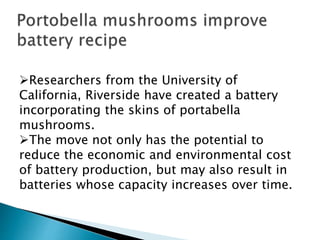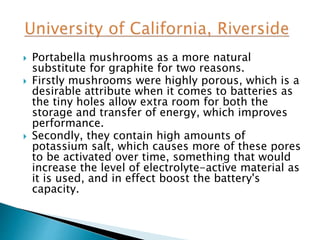Portobella Mushroom
- 2. One of the most imposing mushrooms in size. It has a rounded, earthen tan flat cap with near black gills on its underside. Stem is thick, white and edible. Very memorable, rich and meaty texture and flavor, which it retains even after cooking.
- 3. Natural source of vitamin D. The amount of vitamin D they contain depends on the amount of exposure to ultraviolet light. Portobella mushrooms are a rich source of copper and selenium. Up to 28% of an individual’s recommended dietary allowance can be obtained from Portobella mushrooms. The fully mature Agaricus bisporus is also a good source of vitamin B6 and niacin.
- 4. They have a "meaty" texture and can be substituted for other proteins. Use in soups and stews, baked pasta or rice dishes, as a beef substitute or in salads. Pair with fresh herbs, fresh cow's milk cheeses, tomato or cream-based sauces, leafy greens, garlic and onions. Mushroom caps should be kept dry and refrigerated until ready to use; they will keep for up to a week.
- 5. Researchers from the University of California, Riverside have created a battery incorporating the skins of portabella mushrooms. The move not only has the potential to reduce the economic and environmental cost of battery production, but may also result in batteries whose capacity increases over time.
- 6. Batteries consist of three main elements: a negative terminal (cathode), a positive terminal (anode) and a solid or liquid separating them (electrolyte). Synthetic graphite is commonly used for the anode in lithium-ion batteries, but this material requires the use of chemicals such as hydrofluoric and sulfuric acids for purification and preparation. These processes are not only expensive, but also produce hazardous waste that is harmful to the environment.
- 7. Portabella mushrooms as a more natural substitute for graphite for two reasons. Firstly mushrooms were highly porous, which is a desirable attribute when it comes to batteries as the tiny holes allow extra room for both the storage and transfer of energy, which improves performance. Secondly, they contain high amounts of potassium salt, which causes more of these pores to be activated over time, something that would increase the level of electrolyte-active material as it is used, and in effect boost the battery's capacity.
- 9. The research was published in the journal Nature Scientific Reports. Source: University of California,Riverside








